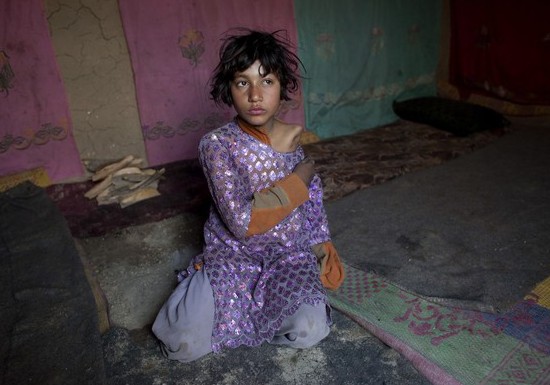
For more on the pictures go here

Dave Eggers, reviewing a collection of early Kurt Vonnegut stories, offers the obiter dictum that “Vonnegut left the planet just about the time we, as a nation, were crawling toward the light again.” Well, I wonder.
For me, it’s difficult to choose the greater disaster unwinding in this new enlightened phase in our history. Is it the health care debacle? Obama’s ongoing one-upping of Bush era Constitutional transgressions? The fact that our economy has fallen down and can’t get up? Or is it the war that nobody sees or cares about? Every day one of these becomes the leading contender. For today, arbitrarily, I’ll choose Afghanistan, mainly because of this typically insightful Tomdispatch essay, Afghanistan as a bailout state.
The state of affairs, as Englehardt writes, is dire:
Here’s a partial rundown of news from that devolving conflict: In the last week, Nuristan, a province on the Pakistani border, essentially fell to the Taliban after the U.S. withdrew its forces from four key bases. Similarly in Khost, another eastern province bordering Pakistan where U.S. forces once registered much-publicized gains (and which Richard Holbrooke, now President Obama’s special envoy to the region, termed “an American success story”), the Taliban is largely in control. It is, according to Yochi Dreazen and Anand Gopal of the Wall Street Journal, now “one of the most dangerous provinces” in the country. Similarly, the Taliban insurgency, once largely restricted to the Pashtun south, has recently spread fiercely to the west and north. At the same time, neighboring Pakistan is an increasingly destabilized country amid war in its tribal borderlands, a terror campaign spreading throughout the country, escalating American drone attacks, and increasingly testy relations between American officials and the Pakistani government and military.
Meanwhile, the U.S. command in Afghanistan is considering a strategy that involves pulling back from the countryside and focusing on protecting more heavily populated areas (which might be called, with the first U.S. Afghan War of the 1980s in mind, the Soviet strategy). The underpopulated parts of the countryside would then undoubtedly be left to Hellfire missile-armed American drone aircraft. In the last week, three U.S. helicopters — the only practical way to get around a mountainous country with a crude, heavily mined system of roads — went down under questionable circumstances (another potential sign of an impending Soviet-style disaster). Across the country, Taliban attacks are up; deadly roadside bombs or IEDs are fast on the rise (a 350% jump since 2007); U.S. deaths are at a record high and the numbers of wounded are rising rapidly; European allies are ever less willing to send more troops; and Taliban raids in the capital, Kabul, are on the increase. All this despite a theoretical 12-1 edge U.S., NATO, and Afghan troops have over the Taliban insurgents and their allies.
A rational person, or nation, would see such a state of affairs and declare that it’s time to cut one’s losses. But that ain’t gonna happen with a president who only wants to please. As Englehardt has written, the only options he’s contemplating include the word “more.” This invokes comparisons to, er, a previous military engagement that didn’t end well. But even that might not convey the scale of catastrophe we’re courting:
In the Vietnam era, there was a shorthand word for this: “quagmire.” We were, as the antiwar song then went, “waist deep in the Big Muddy” and still wading in. If Vietnam was, in fact, a quagmire, however, it was so only because we made it so. Similarly, in changed circumstances, Afghanistan today has become the AIG of American foreign policy and Obama’s team so many foreign policy equivalents of Bush Treasury Secretary Hank Paulson. And as with the economy, so with the expanding Af/Pak war: at the end of the day, it’s the American taxpayer who will be left holding the bag.
Let’s think about what this means for a moment: According to the U.S. Congressional Research Service, the cost of keeping a single American soldier in Afghanistan is $1.3 million per year. According to Greg Jaffe and Karen DeYoung of the Washington Post, it costs the Pentagon about $1 billion per year to station 1,000 U.S. troops in that country. It’s fair to assume that this estimate doesn’t include, among other things, long-term care for wounded soldiers or the cost of replacing destroyed or overused equipment. Nor do these figures include any civilian funds being spent on the war effort via the State Department, nor undoubtedly the funds being spent by the Pentagon to upgrade bases and facilities throughout the country. In other words, just about any decision by the president, including one simply focused on training Afghan soldiers and police, will involve an outlay of further multi-billions of dollars. Whatever choice the president makes, the U.S. will bleed money.
…..
The United States lived through all the phases of escalation, withdrawal, and defeat in Vietnam without suffering great post-war losses of any sort. This time we may not be so lucky. The United States is itself no longer too big to fail — and if we should do so, remind me: Who exactly will bail us out?
Crawling toward the light? I’ll agree with the crawling part…..